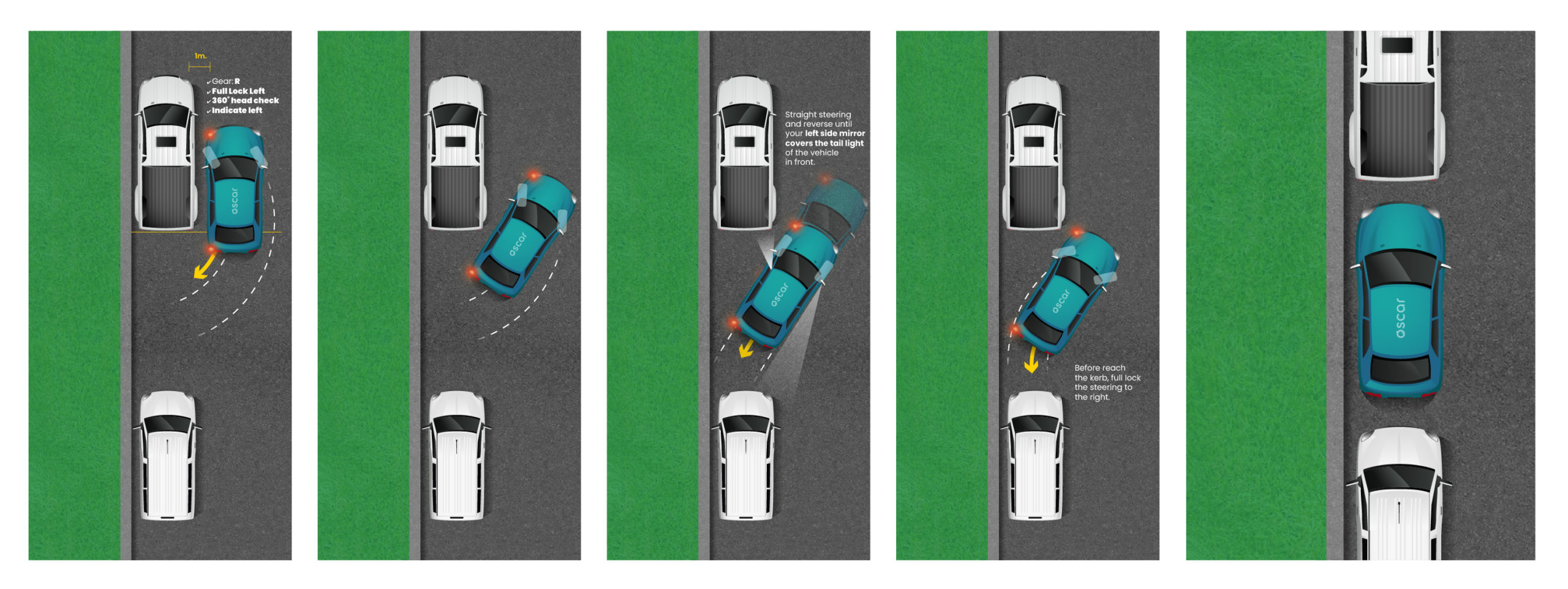






Search and compare prices at thousands of parking locations.

Select a car space, edit your booking time and pay securely.

Follow the easy directions and access instructions.
Mastering the art of How To Reverse Parallel Park is a crucial skill for drivers, especially for those navigating the practical driving test in Australia. This manoeuvre is often included as part of the examination, requiring learners to execute it flawlessly. Alongside reverse parallel parking, there are several other manoeuvres that learners must perform to demonstrate their competence, including a U-turn, hill start, reversing exercise, turn around, and automatic gear change.
In this comprehensive guide, we will focus on the ins and outs of reverse parallel parking, providing step-by-step instructions to help you ace this essential driving skill.
Before diving into the step-by-step process, it’s essential to understand the basic concept of reverse parallel parking. This manoeuvre involves parking your vehicle parallel to the curb but in the opposite direction of the traffic flow. The goal is to position your car within a designated parking space, aligning it evenly with the vehicles in front and behind.
To begin, find a parking space that is at least one and a half times the length of your car. Ensure there are no obstructions, and the space is legal for parking.
Pro Tip: Practice in a less crowded area initially to build confidence.
Approach the parking space at a slow, controlled speed. Signal your intention to park, check your mirrors, and position your vehicle roughly one meter away from the car parked in front of your chosen space.
Pro Tip: Ensure your signal is visible to other road users.
Before initiating the manoeuvre, conduct a thorough check of your blind spots. This includes looking over your shoulder to assess the traffic situation.
Pro Tip: Utilize your side mirrors to supplement the blind spot check.
Shift your vehicle into reverse gear and start reversing slowly. Keep a close eye on your surroundings, including the distance between your car and the one behind. Once your side mirror reaches their back window, get ready to full lock.
Pro Tip: Use gentle and precise steering movements to maintain control.
Now, you need to reverse straight to move closer to the kerb. Turn the wheels straight and reverse until your left side mirror covers the taillight of the vehicle in front.
Before reach the kerb, full lock the steering to the right. This allows the front of your car to swing into the parking space.
Pro Tip: Practice this movement in an open space to get a feel for the turning radius.
Once your car is at a 45-degree angle to the curb, straighten your wheels. Continue reversing until your car is parallel to the curb.
Pro Tip: Use reference points, such as the curb or a nearby object, to gauge your alignment.
If your car isn’t perfectly aligned or if you’re too far from the curb, you may need to adjust by moving forward and backward. Make these adjustments slowly and carefully.
Pro Tip: Take your time; precision is more important than speed.
Once satisfied with your positioning, shift to park, engage the handbrake, and turn off the engine. Congratulations, you’ve successfully executed reverse parallel parking!
Pro Tip: Take a moment to observe your surroundings before exiting the vehicle.

Many learners struggle with accurately judging the distance between their car and the vehicles in front and behind. Practice regularly to improve your spatial awareness.
Neglecting blind spot checks is a common error. Develop a habit of checking blind spots before every manoeuvre, ensuring you’re aware of surrounding traffic.
Smooth and controlled movements are key to successful reverse parallel parking. Avoid sudden accelerations or harsh steering inputs, as these can lead to imprecise parking.
Utilize reference points, such as the curb or nearby objects, to gauge your positioning. Consistent use of reference points enhances accuracy.
So, there you have it – Our guide on how to reverse parallel park!
Mastering reverse parallel parking is an essential skill that not only contributes to passing your driving test but also ensures you can navigate urban environments with confidence. Through consistent practice and adherence to the step-by-step guide, you’ll develop the proficiency needed for stress-free parking in various situations.
and if all else fails… no stress! Oscar has your back! Whether you’re going to hang with friends or simply navigating your daily routine, Share with Oscar provides a hassle-free solution for your parking needs. With a network of convenient and easy parking spaces, you can streamline your parking experience effortlessly.
Most of our parking spots are in Hotels, home driveways or shopping centers (no parallel parking necessary. Making every journey a smooth and enjoyable one. So, leave the parking worries to Oscar and focus on enjoying the open road with confidence.
Happy Parking!